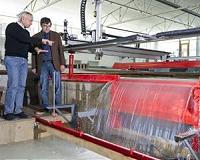 |
Berlin, Germany (SPX) Oct 28, 2010 Batteries are certainly the most familiar energy storage devices - reliable, available everywhere and convenient. Rechargeable batteries are ideal for cell phones and electric cars, but for large amounts of energy, to overcome shortages in the power grid, they are not the best solution. What other options are available to us today? Pumped-storage hydroelectric plants play the biggest role in the European grid. In Germany alone, the installed capacity is now seven gigawatts. The alpine countries, Austria and Switzerland, with their mountainous landscape, can meet their short-term energy needs with hydroelectric power. However, their storage potential cannot be increased any further and the Alps cannot play the role of a 'battery' for all of Europe. Norway and Sweden have many possible locations for new pumped-storage hydroelectric facilities, but the grid connections to central European consumers would be costly and have yet to be built. "Flat coastal areas, where it is predicted that the largest demand for energy storage will be in the future, are unsuited to this technology," says Stefan Zunft from the DLR Institute of Technical Thermodynamics in Stuttgart.
Pumped-storage hydroelectric plants in disused opencast mines Short term excess capacity on the grid could be used to pump water into a basin elevated 10 to 30 100 to 400 metres above ground and enclosed by a ring wall which would then drive turbines when released into the surrounding lake. Disused opencast mines could be a good location for such facilities. Today, these are being turned into large lakes, but they could be supplemented with ring-wall islands in the future. Another option for flat areas would be underground compressed air storage, a concept Stefan Zunft's team at DLR is working on. "The technology has enormous potential throughout north-western Europe," says Zunft. One option would be to force air into underground salt caverns and store it there under pressure. If an energy shortfall occurs, the air warmed by another heat storage device could be used to drive generators. Efficiencies of up to 70 percent are possible, almost as high as is attainable with pumped-storage hydroelectric plants. The ADELE pilot project will be launched in 2013, with a storage capacity of up to one gigawatt-hour.
Flywheels the renaissance of an old technology When power is needed, the flywheel is coupled to a generator, which converts the kinetic energy back into electricity. This technology has an extremely high efficiency up to 95 percent. In principle, it can make megawatts of energy available on demand for short periods. An intermediate storage in the form of chemical energy is also an option for the future. The best candidate for this is hydrogen, with its high energy content. Excess capacity could be used to generate hydrogen by means of electrolysis, which could then be used in fuel cells for use when required. However, these conversions reduce the overall efficiency, although work is being done to increase it.
Share This Article With Planet Earth
Related Links DLR Institute of Technical Thermodynamics Powering The World in the 21st Century at Energy-Daily.com
 Small Is Beautiful In Hydroelectric Power Plant Design
Small Is Beautiful In Hydroelectric Power Plant DesignMunich, Germany (SPX) Oct 27, 2010 Hydroelectric power is the oldest and the "greenest" source of renewable energy. In Germany, the potential would appear to be completely exploited, while large-scale projects in developing countries are eliciting strong criticism due to their major impact on the environment. Researchers at Technische Universitaet Muenchen (TUM) have developed a small-scale hydroelectric power plant that so ... read more |
|
| The content herein, unless otherwise known to be public domain, are Copyright 1995-2010 - SpaceDaily. AFP and UPI Wire Stories are copyright Agence France-Presse and United Press International. ESA Portal Reports are copyright European Space Agency. All NASA sourced material is public domain. Additional copyrights may apply in whole or part to other bona fide parties. Advertising does not imply endorsement,agreement or approval of any opinions, statements or information provided by SpaceDaily on any Web page published or hosted by SpaceDaily. Privacy Statement |